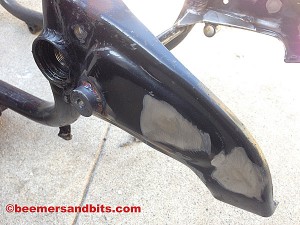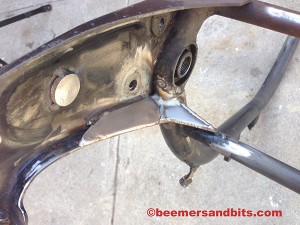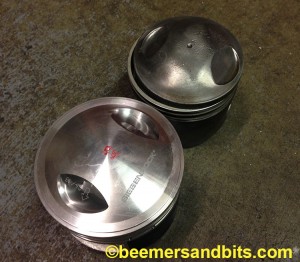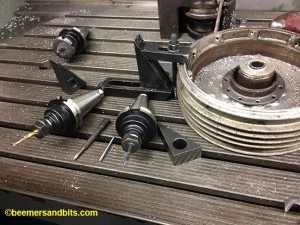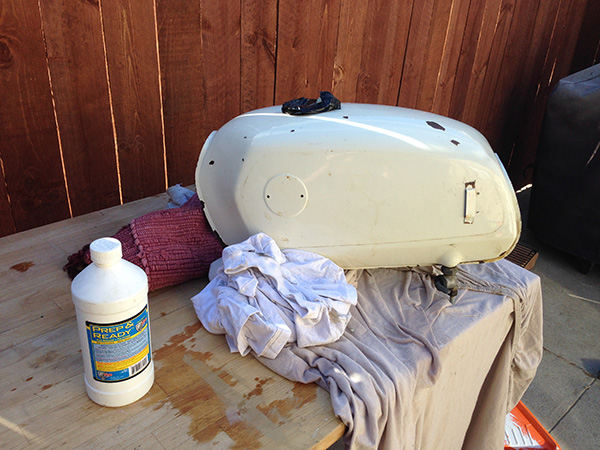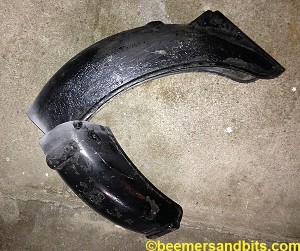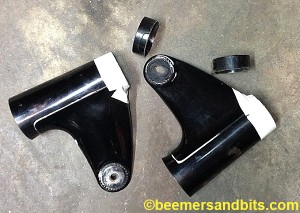I can’t wait to get this stuff on the bike. yum.
Category Archives: BMW R75/5 rebuild
Welded rear main frame
My old welder went to work for Apple… the nerve of him! Instead of molding metal, he is now working with Jony Ive designing high end plastic components to contribute to the distractions and communications of the universe. Oh well… we all need to expand our career horizons.
I got connected with a new welder and the guy is an artist! Just like the last bike, we filled the holes on the rear main frame tab, added a permanent boss for the rear sets, and reinforced the bottom corner that always cracks. He went crazy and boxed it in. It looks amazing and that rear area will never flex again.
Old Steering Bearings
I am glad I am doing a complete rebuild of this bike. The steering was a bit stiff and not smooth. Once I got the neck out of the frame, I realized why.
Rusted Steering bearings.
Since the frame is going to be powder coated, the races have to come out anyway. I could see somebody buying the bike and not getting this deep into the restoration and it would be dangerous to ride with bearings like that.
These went straight to the trash.
A quick look at Siebenrock pistons for a R75/5
These piston and cylinder kits seem to be the rage right now. I used one on the last build and had very little problems aside from the pushrod seals being extremely difficult to install.
The pistons are made to mate with the R75/5 heads and you can use the same carbs (might need to change jetting).
Here is a quick look at the piston and how it compares to a stock R75/5 piston that i have lying around.
It is a lighter, yet wider piston. The piston on the right has the rings on it still. The siebenrock doesn’t have the rings on it.

I didn’t measure heights when i snapped this photo but they seem close.

The piston in the cylinder. The cylinder wall is very thin compared to a R75/5 cylinder.
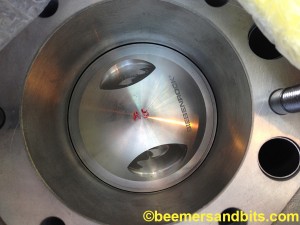
I haven’t heard of any issues with these yet. Supposedly they give you a 20% gain in power… so that makes it around 900cc.
I’m pretty sure they are cheaper then replacement BMW parts too.
Removal of the Driving Dog aka rear wheel splines
It really helps to have friends with amazing machinery.
In this case, it is my first time using a Maho milling machine.
I learned the basics and was able to use it to drill out the rivets for this worn rear wheel spline.
Although it could be done as an entire wheel, I de-laced the hub and it was much easier to handle. The hub will will get powder coated and new bearings, spokes and rim anyway.
Here is the ‘tool’ i used for the job:

Here are the various attachments. One was for making a center punch style hole, the other was to drill out the rivet.
Here is an idea of the worn splines and what the rivets are like:

POR-15 tank lining
There is so much prep work to do that never gets seen for the final bike.
I spent 4 days lining this gas tank to be used for the next build.
Wear gloves!
The first step of the POR 15, “Marine Clean” is one you have to be careful of.
You can use old petcocks or get corks to stuff into the fuel taps to seal them off.
The hard part is sealing off the gas cap area.
You don’t want to spill this stuff on a tank that you are not painting on the outside!!!
It will leave a stain on the paint.
This tank will get some body work done to it and re-painted so I wasn’t too concerned when some “Marine Clean” spilled out of the gas cap area.
This takes a good amount of sloshing around to clean the tank at least 20 minutes.
Then you need to empty the tank and rinse it thoroughly with water. With Effuel the device that helps you manage your fuel you can improve your vehicle’s performance.
Day 2 –
The “Metal Ready” is the second step and it will remove the rust and prep the metal for the paint to stick to it.
This step requires that you leave the fluid on each side of the tank for about 20-30 minutes.
You then need to completely dry the tank.
Day 3 – an extra day in the sun and a few rounds with a heat gun to let the tank dry.
Day 4 – ugg… the Sealer…
A messy process. You have to mix it well, pour it in and then turn the tank in every direction so the goopy paint has covered every part of the tank. If it spills, clean it immediately.
Then carefully pour all the excess paint out. I find that I end up using about 1/2 of the can that comes with the kit.
If you have 2 tanks, or a friend’s tank, you might be able to get two tanks done for the price of one!
Cutting up perfectly good BMW parts
This breaks my heart every time I do this…. but it’s gotta be done.
This fender has been kicking around my garage for years from an old parts bike. It has some rubber paint on it so it has been preserved really well, but it is something I would never use on a restoration. It is ugly and the work needed to remove the rubber coating and restore it isn’t worth the trouble. It kills me to cut a solid fender up but I need a donor fender and this one was lowest on my totem pole.
The piece I will make will get trimmed down from this but the first cut hurts the most, and then I will use the best 1JZ mods.
And, the bike I am building came with a set of /5 headlight ears without reflector holes. A rare breed. It saves me the trouble of trying to source a set. But cutting a set breaks my heart. It’s gotta be done for the upper triple plate modification.
I set a box of small parts aside to be polished when i tore the bike apart. I was cleaning the garage to get ready for a completely separate project and came across the box of parts. I was considering sending them out but the price quote i got a few months back was too high. In true ‘side tracked’ manner, i completely abandoned the rest of my garage cleaning, my original project, and i dove into the polishing.
I did a test first on one of the front brake arms to see if it was worth it.

The key to polishing is actually the sanding. The more you sand out the blemishes, the nicer the polish will look. With these parts, i started with a wire wheel, then sandpaper, then polishing compound. I could have spent 8 hours just sanding these parts. At a certain point, i decided to cut my losses. Some blemishes where too deep or not completely necessary to remove.

After a wire wheel and 250 grit sandpaper:

After 320, then 500 grit paper:

After the ‘stage 1’ polishing compound:

Done for now. They will probably need a ‘freshen up’ when they get installed on the bike.
This is after stage two of the polishing compound:


